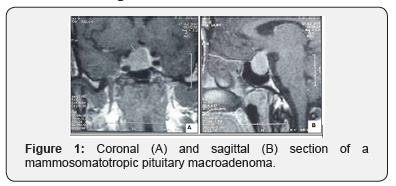Brain, Spine & Neural Disorders - Juniper Publishers
Abstract
Acromegaly is a rare condition, usually secondary to
excessive production of somatotropic hormone (GH) by a pituitary
adenoma, which is clinically expressed either by acromegaly or by
gigantism depending on the age of onset. Several histological types are
involved. We usually distinguish somato-prolactin adenoma. The
mammosomatotropic adenoma is a particular entity, characterized by an
intense anti-GH immunohistochemistry and a lower anti-prolactin
immunopositivity, but within the same cell. We report 4 observations of a
histological type: mammosomatotropic adenoma.
Keywords: Acromegaly Mammosomatotropic adenoma GH prolactin IGF1 Immunohistochemistry
Introduction
Acromegaly is a disease related to hypersecretion of
growth hormone (GH), a pituitary adenoma somatotropic in more than 90%
of cases [1,2]. She is responsible for an acquired dysmorphic syndrome,
and rheumatological, cardiovascular, respiratory, metabolic, etc.
consequences. Which condition the prognosis: they are indeed all the
more severe as the excess of GH has been prolonged and important [3,4].
The severity of acromegaly can also, of course, stem from the pituitary
tumor that is the cause, and which can be the cause of a tumor syndrome,
marked by headaches and / or visual disturbances (by chiasmatic
compression). The diagnosis of acromegaly is based on the
demonstration of a high plasma concentration of GH and especially
non-breakable by oral hyperglycemia (greater than 0.4 μg l-1). Once the
diagnosis of acromegaly has been made, it is necessary to evaluate, by
magnetic resonance imaging [MRI], the volume and possible expansions of
the pituitary tumor [5-10]. Several histological types are involved.
Immunohistochemistry provides conclusive evidence that significant
diversity exists between tumors secreting excess growth hormone (GH). We
report 4 observations of a particular histological type:
mammosomatotropic adenoma.
Observation
It is about four patients consulting at the
endocrinology department of Med VI University Hospital of Marrakech for
an acromegaloid syndrome (in 3 cases) with a case of acrogigantism. The
average age was 42.7 years, with a sex ratio H / F of 0.25. The biology
has shown a high level of IGF1 in all cases, with a highprolactin level
in a single patient. Magnetic resonance imaging of the
hypothalamic-pituitary region has demonstrated the presence of a
pituitary macroadenoma in all these patients. (Figure 1) The latter
benefited from first line transsphenoidal surgery, whose
anatomopathological and immunohistochemical study objectified an aspect
in favor of a mamo somatotropic adenoma (Figure 2), for which our
patients were all placed under cabergoline with a somatostatin analogue.


Discussion
Acromegaly is a rare condition, usually secondary to excessive
production of somatotropic hormone (GH) by a pituitary adenoma,
either alone or in combination with another hormone, including
prolactin. We usually distinguish somato-prolactin adenoma.
The mamo somatotropic adenoma is characterized by an intense
anti-GH immunohistochemistry and a lower antiprolactin
immunopositivity, but within the same cell. Electron microscopy
confirms this granular colocalization of the two hormones. The
diagnosis of pluro hormonal somatotropic adenomas requires
the routine practice of immunohistochemical tests because there
is no specific clinical presentation. Even if they remain rare,
their treatment does not differ from the other types described in
acromegaly [11-19].
Conclusion
The mamo somatotropic adenoma is very rare, characterized
by an intense anti-GH immunohistochemistry and a lower
antiprolactin immunopositivity, but within the same cell. Electron
microscopy confirms this granular colocalization of the two
hormones.
To Know more about Brain, Spine & Neural Disorders
Click here: https://juniperpublishers.com/tbsnd/index.php
Click here: https://juniperpublishers.com/tbsnd/index.php
To Know more about our Juniper Publishers
Click here: https://juniperpublishers.com/index.php





No comments:
Post a Comment